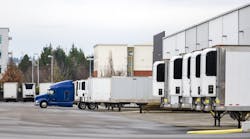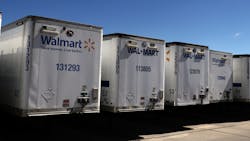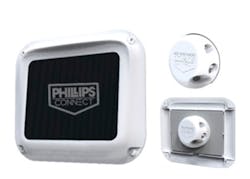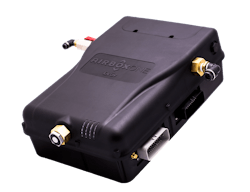Operating officers, fleet managers, and dock coordinators use all manner of tracking hardware and off-the-shelf and even custom-built software to try and accomplish the goal of maximizing their trailer utilization.
Like so much else in trucking now, the battle for visibility and availability of a carrier’s trailer fleet is about technology. First, the software that manages and routes loads and the yards where this cargo is handled. And then the hardware that helps track trailer locations and what’s loaded on them and other security tech that gives fleet managers “live looks” inside the trailer, telling them whether and where trailer doors have been sealed or opened.
See also: Smart trailers are making trucking more efficient
“Off-the-shelf” transportation management systems (TMS) play a key role. Top off-the-shelf systems include 3Gtms, BluJay, Descartes, Blue Yonder, Kuebix, MercuryGate, Oracle, SAP, Trimble, and Transplace in one rating by InTek Freight & Logistics, a North America-focused logistics company based in Indianapolis. But often, fleets that are large enough have custom systems tailored to their needs by some of these same vendors.
“Technology is an enabler of efficiency. Our philosophy where possible is to design our own applications,” said Frank Granieri, chief operating officer of West Chester, Pennsylvania-based A. Duie Pyle, adding that Pyle’s software solutions for trailer management are proprietary and that the company is "lucky enough" to retain around 30 professional staff software developers to aid in tailoring its fleet- and yard-management tools.
Orbcomm, for example, recently launched a next-gen Internet of Things (IoT) solution for a specialized trailer market: refrigerated containers, or “reefers.” Orbcomm’s CT 3500 IoT telematics device, which the tech provider maintains is an evolution in smart management of refrigerated containers and their perishable cargoes, enables end-to-end, remote visibility and control of containerized assets and shipments on roads, rail, and sea.
According to the company, its data-driven refrigerated container solution features enhanced functionality, analytics capabilities, connectivity options, and interoperability with third-party telematics devices, helping shippers and carriers around the world drive efficiencies in reefer container logistics.
“Orbcomm’s latest innovation in reefer container telematics demonstrates our leadership in developing feature-rich technology solutions that meet the evolving needs of the shipping industry’s complex supply chains,” said Al Tama, Orbcomm’s VP of container and port solutions. “The enhancements we’ve made to our refrigerated container solution deliver advanced temperature management capabilities and streamlined container operations to help customers make data-driven business decisions while improving profitability and the customer experience.”
Great Dane's FleetPulse is one of the more prominent telematics products on the trailer technology market. FleetPulse offers real-time data from advanced onboard sensors that is presented in a dashboard and mobile app.
Onboard 'gateway' and software to translate the data
Commercial tracking systems for several trailer segments generally consist of two elements. The first is a battery- or solar-powered device attached to the trailer itself that emits a GPS tracking signal that communicates with the backend through the use of a cell modem. This allows the user to ascertain where the trailer is located at any given moment. The second part of the system is the software on the receiving end, which can translate the signal from the trailer tracker graphically onto a map, showing the exact location, whether the trailer is stationary or moving, and in some cases, whether it is hooked to a tractor.
Many of these devices utilize geofencing, an invisible barrier set up by using GPS coordinates around a selected area. Predetermined geofences can be set up around fleet yards or trailer storage areas or other venues. If a trailer ends up outside a specified geofence, the deviation will trigger an electronic alert at dispatch. This is valuable for trailer tracking but also for security and the prevention of cargo theft.
See also: Phillips Connect, Utility Trailers launch smart trailer partnership
During a conversation with FleetOwner, Jessica Smith, VP of customer and data insight for Phillips Connect and a 25-year veteran of Werner Enterprises, the Omaha, Nebraska-based freight transportation and logistics provider that is ranked No. 12 on the FleetOwner 500: Top For-Hire Fleets of 2022 list, previewed Phillips Connect’s new and upcoming products and reviewed the legacy tech that fleets like A. Duie Pyle and Werner have used to track their assets for years.
CargoCheck, Phillips Connect’s latest ultrasonic cargo sensor, can tell when a trailer is empty or loaded, and door sensor DoorCheck can tell if a trailer has entered a geofence or has been idle before it’s unloaded and can be paired with CargoCheck, which sends an update to fleet managers when a door has been opened. Another of the vendor’s products, CargoVision, can take a photo of the inside of the trailer to go along with the update, Smith said. Yet another product, SmartPair, which is mounted to the tractor, “makes sure the right tractor has connected with the right trailer before they go 10 miles or 1,000 in the wrong direction,” Smith added.
The vendor also is in R&D with “a bunch of maintenance sensors” that will cover many of the items on the U.S. Department of Transportation’s multilevel commercial truck inspection checklist and is partnering with wheel-end monitor vendors—such as SKF, ConMet, P.S.I., and Hendrickson—to communicate through the Phillips Connect onboard gateway, according to Smith. Wheel-end monitors provide early warning of hub, brake, and tire problems before they turn into “thermal events” on tractors but much more often on trailers. Several of these products are exclusively made to be mounted on trailers.
More Phillips Connect cargo security devices will include SmartLock, which will feature a heavy-duty stainless steel pin and will only be able to be unlocked remotely or when the trailer it’s mounted to enters an authorized geofence, Smith said.
See also: Wheel-end monitors: From system to data to prevention
Other systems, such as Drōv Technologies’ AirBoxOne, takes trailer intelligence well beyond trailer tracking. AirBoxOne provides a platform for smart trailer sensor aggregation and applications, including a sophisticated tire inflation/deflation system based on load as well as advanced camera capabilities.
Hickman added, “Drōv’s system is attractive because it directs the massive amount of data traffic to an established and usable dashboard that provides fleets with an immediate way to receive [that] ‘actionable’ data.”
Carrier Logistics Inc. (CLI), a provider of freight-management and cross-docking software, in May introduced a new fleet yard-management system that allows asset-based LTLs (CLI’s primary customer) to juggle yard operations at their terminals—where the rubber can meet the road in terms of saving or wasting time in dealing with trailer utilization.
“Error in linehaul particularly (the movement of freight or goods across different modes of transport by land, air, waterway, between distant cities, ports or even warehouses) is very costly, if [for example, freight] on a Miami trailer was accidentally delivered in Dallas. It’s very hard to recover a shipment that went 600 miles in the wrong direction,” Ben Wiesen, CLI president, told FleetOwner.
“This led us into our yard-management system. We realized another part of the operation that our LTL carriers were losing track of was yard management,” Wiesen continued. “It was easy to lose track of a trailer. Some yards are fairly big. If you’re wasting time finding a trailer, that’s a cost and efficiency problem.”
He concluded, “Without software, LTL companies tend to have trailers that they just forget about or that aren’t doing anything productive.”
This is Part 2 of a feature that appeared in the August edition of FleetOwner magazine. Part 1 appeared earlier this week.






